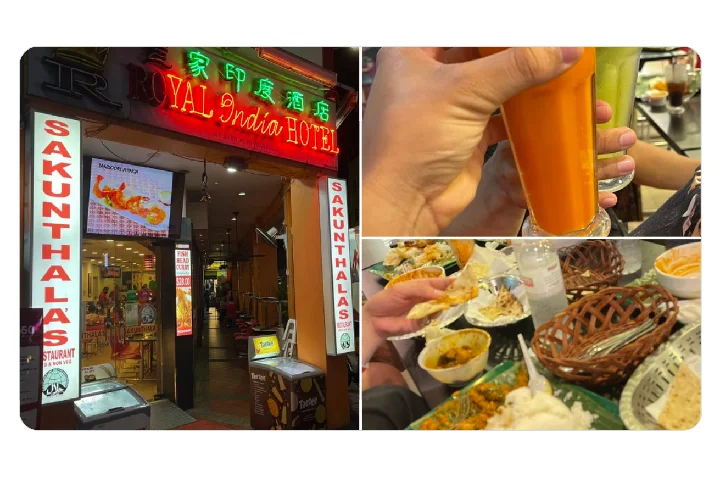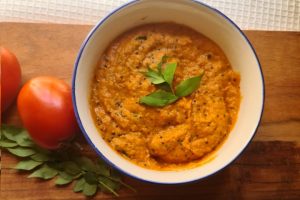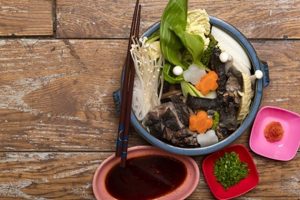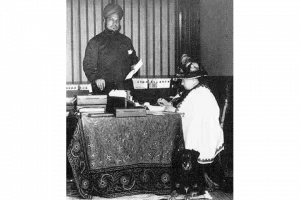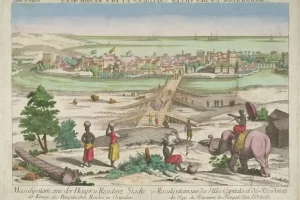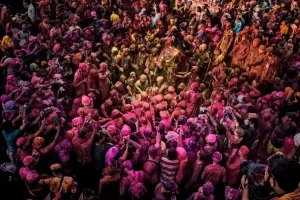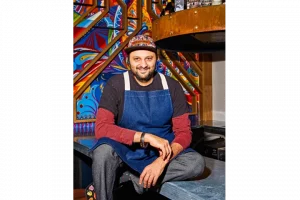Right in the heart of Singapore’s busy commercial district, home to many highly-paid expat Indians these days, is Lau Pa Sat, a popular hawker’s centre with street food to satisfy all cravings—from noodles to hot pots, roti canai to Thai and Malay curries.
Lau Pa Sat, or “the old market”, is in fact one of the oldest Victorian era structures in South East Asia. The wrought iron canopy and frame of this covered market was made in Scotland in the early 19th century and shipped to Singapore that had been just founded then, in 1819, by Stamford Raffles, the East India Company administrator and architect of Britain’s colonial empire in “Indochine”, the seabound South East Asian lands influenced by the two cultural, superpowers of India and China.
Speaker dinner at Lau Pa Sat. #HITBGSEC pic.twitter.com/wo5n7EvH87
— Cooper (@Ministraitor) August 28, 2019
As Colonial powers jostled in South East Asia in the 19th century, new cultures and cuisines were created from a mix of ideas and people inhabiting the lands bordering the strait, here in Singapore. At Lau Pa Sat, some dishes that show up on our disposable plates one rainy evening in October go back to 19th century India.
“Coolies”, as they were called, or labourers on contract working often in harsh conditions on terrible wages to keep the colonial enterprise going, travelled from southern and eastern India to Singapore, the Malay peninsula, as also to Java and Sumatra to work on plantations and as labourers. In these new lands, they brought their spices and food memories and concocted new dishes out of what they encountered.
Mee Goreng Mamak is one such dish. When it arrives at our table, the Indian style fried noodles are bright orange in colour (in Singapore, they are orange but not in Malaysia, where the yellow noodles are made spicier than Chinese style ones), are a bit sticky and also a bit spicy. They are dubbed “mamak” style, from the Hindi word “mama” or “uncle” used for Indian workers of 19th century, many of whom set up shophouses to sell daily necessities as also some street food, including the Indianised noodles. In Malaysia too, mamak is the word to connote Indian style, a throwback to an immigrant culture where “uncle” is an honorific to address elderly strangers.
Know about Sri Veerama Kaliamman Temple
It is known as Soonambu Kambam Kovil, it is a Hindu temple located in middle of Little India in the southern part of Singapore.The temple started as a shrine dedicated to Hindu goddess Kali in 1855 before built by Bengali labourers in 1881 pic.twitter.com/T2xUES7RJF— Raj Shree (@RajShre88419631) August 8, 2022
As I walk through the clean, fascinating, narrow bylanes of ChinaTown in Singapore, one of the oldest enclaves for immigrants to this port city developed by Raffles—the eponymous Colonial era hotel still draws hundreds of tourists per day, who come to sit in the Long Bar and sip on the Singapore Sling, a cocktail concocted here, and to shell peanuts at the tables, throwing the shells on the ground to be picked up by a blue collared worker of yore– large murals depicting some of these early mamak shophouses (houses on top, commercial shops below) are striking throwbacks to Singapore’s colonial history.
The fried “mamak” noodles themselves that originated as street food in the 19th century here are now a culinary legacy, even if few may relate the bright orange food colouring to how biryani rice is often coloured in the Subcontinent by the poor when saffron cannot be afforded.
There are other 19th century dishes that bind the Straits to Colonial India. Parata, as it is called, or roti-parata is a Singaporean (as also Malay and Indonesian) snack that is a sibling of Calcutta’s Mughlai Parata. The “roti-parata”, is alternatively called “roti canai” or “murtabak” in Malaysia and Indonesia and kottu roti in Sri Lanka. All these are tweaks to Calcutta’s Mughlai Parata, itself a street dish that came about as an innovation from the Lucknowi tradition of egg-laced warqi parathas eaten with mince or fine nuqti kebab.
https://twitter.com/hussainjahanzeb/status/1200821496123408384?s=20&t=tweXS5pr9M0vAvR67gJvPA
Calcutta, the 19th century capital of the East India Company, dubbed the Second City of the Empire after London, became the last refuge for a dying Lucknowi culture and cuisine after Wajid Ali Shah, the beleaguered last nawab of Avadh was exiled to Metia Burj here. Along with his entourage came erstwhile Mughalai cooks, artisans, courtesans to this new cosmopolitan city, as also common men from the villages of Bihar and Bengal, who migrated to Calcutta to work and feed themselves as the Colonial economy, and European wealth grew by impoverishing India’s villages.
Dishes that had been part of home dining (or simple halwai dishes such as kachauri in the temple towns of UP) now began to assume a street life of their own in Calcutta, reworked as fried snacks and meals to keep the hungry workers full at a cheap price.
Mughlai Paratha, now conveniently stuffed with mince, became a delicious snack that could be eaten on the go, or inside the more gentrified Cabin style eateries, later frequented by the new middle class too.
With Strait territories, including Singapore, being part of the Bengal presidency, office workers, accountants, clerks as well as labourers or coolies from India made up for a wave of immigration to South East Asia, carrying with them the idea and recipe of this newly minted “parata” snack. Today, the parata is firmly Singaporean not just a Calcutta classic.
When “coolies” or indentured labourers arrived in the Strait settlements, they were dubbed “Kling” by existing communities of Chinese, Malay, Europeans as well as older Indian immigrants. This was a corruption of “Kaling”– people hailing from Kaling, the poor eastern regions of present day Bengal, Orissa and Andhra. Kling became a pejorative term eventually.
But while the coolies were poor immigrants, Indians had been part of Malay and Singapore’s history for much longer, occupying positions of social and political power and prestige since as long as the 10th century.
Singapore wasn’t far behind in returning the favour. There was a ‘Kling’ street, for a very long time. The term “kling” is a corruption of “Kalinga”, the name of an ancient empire in southern India that traded with the Malay Peninsula, Java and Sumatra. Pics attached. pic.twitter.com/7RxOlJvpTC
— Kanishk Samota (@KanishkSamota) March 22, 2021
As we do a tour of Singapore’s oldest settlements, Kling street has given way to “Chuliya” street, a term that carries with it prestige. If the old Chinese “millionaire’s club” in a quiet, leafy neighbourhood of Singapore’s ChinaTown is a throwback to moneyed Chinese businessmen who thrived under Colonialism, Chuliya street is testimony to the legacy of Indian financiers and traders from southern India, who traced their ancestry back to the chettiars of Chettinad, who in turned traced their ancestry back to the mighty Cholas.
The chettiyars in Singapore and Malay, who came as British colonialism spread, and financed both the locals and the Europeans, are important links between India and South East Asia. And while, their presence grew with Colonialism, communities of South Indian merchants already existed in South East Asia, in Singapore, Malaysia and Sumatra, since the 11th century.
Chuliya, in fact, is a corruption of “chulan” or “cholan”, an ancient surname adopted by many political elite in the Straits, including by royal Malaysian families, as my guide Shanti Tauvy, whose passion is Singapore’s historical heritage, mentions.
As I dig more, the connections become more apparent. The great Chola empire (that has occupied popular imagination this year, most recently thanks to the success of the movie Ponniyin Selvan) had trade links with the Song dynasty in China. Rajaraja Chola in fact sent a delegation to the Song court in China in the 10th century.
But in 1025, Rajendra Chola, his successor carried out what has been possibly the only Indian military campaign till date in SE Asia– against the dominant naval power of the day, the Srivijaya empire, that was based in Indonesia but also controlled Malacca. Some historical readings conjecture the cause to have been the Srivijaya empire obstructing Chola trade with China, though of course Rajendra Chola may equally have had ambitions to establish suzerainty– as the Sanskritised ideal of the lord of the three worlds or “tribhuvan”; the idea of which is now embedded in cultural and political history of south east Asia.
The Cholas defeated and decimated the Srivijaya empire but they did not establish territory in South East Asia. Nevertheless, the resonance of this victory can be felt across history, including in the founding myth of “Singapura”, or Singapore. Though the word Singapura finds first mention only in the 15th or 16th centuries, a myth traces it to an early village where the port’s mythic founder Sang Nila Utama is supposed to have seen a lion. In folklore, Utama is the progeny of a mythic king “Raja Chulan”, who seems to have been modelled on Rajendra Chola, and a princess of the underwater kingdom.
More accurately, historically speaking, the Chola conquest’s direct impact in the region was increased Indian mercantile activity in Malay, Indonesia and the region—some of these guilds are mentioned in ancient Sumatra, and it is possible that the Chetiyars, who trace their ancestry to the Cholas too, first came about as members of these trading and merchant guilds.
By Colonial times, the community from Chettinad, were well known for their trade in gems and stones as also their palatial homes in Tamil country. Some settled in SE Asia, but with the rise of British Colonialism, their activities and influence spread, and from being traders, they also became bankers and money lenders. Singapore still as a small chettiyar community.
Chettinad Curry Wishes Happy 55th National Day Singapore!!!#chettynadcurrysg #wishes #happy #nationalday2020 #singaporean #55th #NationalDay #singapore #nationaldaysingapore #celebration pic.twitter.com/UUlvW8Y4MJ
— Chettynad Curry Palace (@chettynadcurry) August 8, 2020
Banana leaf meals, as well as Chettiyar spicing influence the culinary traditions of both Malaysia and Singapore, and that is evident in much of the Indian food that you may encounter even today here.
But since culture is a two way street and culinary influences via trade or political conquest spread in both directions, there may be a bit of SE Asia in India’s food traditions too. The idli doesn’t seem to have existed in its current form as a fermented and steamed rice dumpling till about the 12th century. Before this, its prototype seems to have been a dal based dumpling. Food historian KT Achaya conjectures that the modern idli came about thanks to cultural ties with the Hindu kings of Indonesia, where fermentation and steaming were common cooking techniques. The Chola empire may have faded away by the 13th century, but the reverberations of its ties with the water bound kingdoms of south east Asia can be felt on our plates even today.
Also Read: How the British crown impacted Indian food in London and Calcutta
(Anoothi Vishal is the author of Mrs LC’s Table. She is also a columnist and food writer, specialising in cuisine history)






